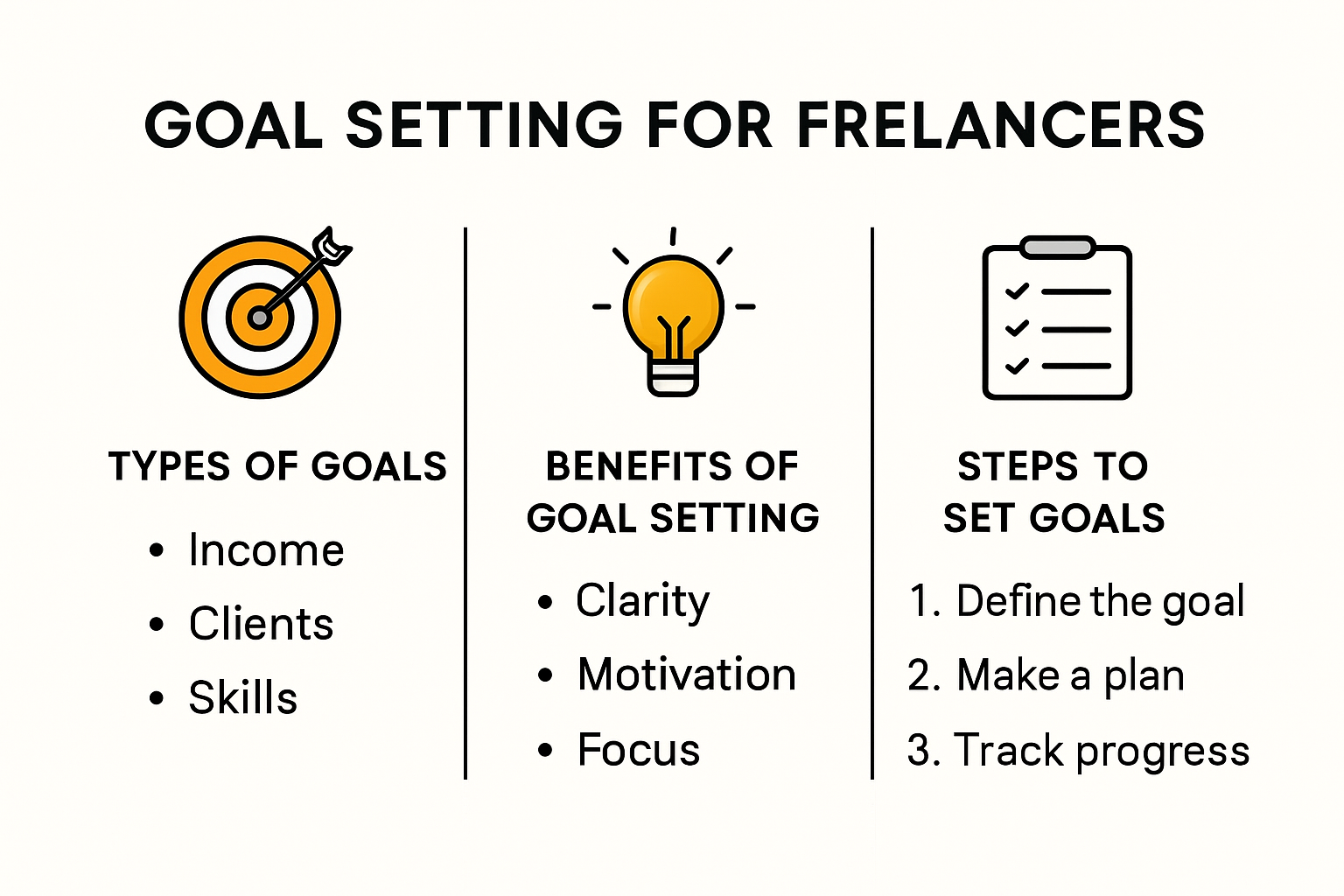Freelancers everywhere are mapping out their 2025 with high hopes and ambitious targets. Most assume that simply working harder or setting generic goals will push them further. But the real leap happens when goals are broken into micro actions and tracked using smart digital tools. Freelancers who break down big goals boost their likelihood of success by up to 42 percent. This shifts simple wishful thinking into a system that can actually deliver results.
Table of Contents
- Understanding The Importance Of Goal Setting
- Smart Goals For Freelancers And Teams
- Tools And Techniques To Track Progress
- Aligning Freelancer Goals With Business Objectives
Quick Summary
| Takeaway | Explanation |
|---|---|
| Set SMART goals for clarity | Utilize the SMART framework to ensure your goals are Specific, Measurable, Achievable, Relevant, and Time-bound for effective progress tracking. |
| Break down complex objectives | Divide larger goals into smaller, manageable tasks to maintain momentum and avoid feeling overwhelmed in your freelance work. |
| Regularly track your progress | Use digital tools and visualization techniques to consistently monitor your goal achievements and stay motivated throughout your journey. |
| Align personal goals with client needs | Understand your clients’ business objectives to ensure your professional growth supports their success, transforming your role into a strategic partnership. |
| Adapt goals based on market trends | Continuously assess your skills and adjust your goals as needed to remain relevant and responsive to changes in your industry. |
Understanding the Importance of Goal Setting
Goal setting represents a critical strategic approach for freelancers seeking professional growth and sustained success. More than a simple planning exercise, it serves as a comprehensive roadmap that transforms abstract aspirations into concrete achievements.

The Psychological Power of Goal Setting
The significance of goal setting extends far beyond mere task completion. Research from Positive Psychology reveals that clear, well-defined goals dramatically enhance focus, persistence, and motivation. Freelancers who establish precise objectives experience improved performance, increased job satisfaction, and greater overall well-being.
Psychologically, goals function as powerful intrinsic motivators. When freelancers articulate specific targets, they create mental frameworks that guide decision-making and resource allocation. This process triggers neurological mechanisms that transform abstract intentions into actionable strategies. By visualizing desired outcomes, professionals activate cognitive pathways that naturally propel them toward achievement.
Breaking Down Complex Goals
Research from Toronto Metropolitan University emphasizes the critical importance of decomposing larger goals into smaller, manageable steps. This approach prevents overwhelm and maintains consistent momentum. For freelancers navigating complex professional landscapes, this strategy becomes especially crucial.
Consider a freelance writer aiming to expand their client portfolio. Instead of viewing this as an intimidating monolithic objective, they might break it down into specific weekly actions: identifying potential clients, crafting personalized outreach emails, updating professional portfolios, and scheduling networking meetings. Each micro-goal becomes an achievable milestone that builds cumulative progress.
Below is a table summarizing how complex freelance goals can be broken down into manageable micro actions and milestones, as discussed in this section:
| Large Goal | Micro Actions | Milestones (Examples) |
|---|---|---|
| Expand client portfolio | Identify potential clients weekly | List 10 target clients by Friday |
| Craft personalized outreach emails | Send 5 outreach emails per week | |
| Update professional portfolio | Finish new samples page by end of month | |
| Schedule networking meetings | Attend 2 relevant events this month |
Implementing SMART Goal Frameworks
Guidance from George Washington University recommends utilizing the SMART framework for effective goal development. This approach ensures goals are Specific, Measurable, Achievable, Relevant, and Time-bound. For freelancers, this means transforming vague aspirations into precise, executable plans.
A SMART goal might look like: “Increase monthly freelance writing income by 25% within six months by securing three new long-term clients in technology and healthcare sectors.” This formulation provides clarity, establishes measurable metrics, remains realistically attainable, directly relates to professional growth, and includes a specific timeframe.
Successful goal setting is not about creating rigid structures but developing flexible, adaptive frameworks that accommodate professional evolution. Freelancers who master this skill position themselves for sustained growth, continuous learning, and strategic career advancement.
SMART Goals for Freelancers and Teams
The SMART goal framework provides a systematic approach to transforming abstract professional objectives into actionable, achievable strategies for freelancers and collaborative teams. Research from edX highlights that this methodology, credited to Dr. Edwin Locke, offers a structured method for effective goal planning and execution.
Crafting Precise Professional Objectives
SMART goals demand a level of precision that goes beyond traditional goal-setting approaches. Each component of the framework serves a critical purpose in goal development. Specific goals eliminate ambiguity, measurable targets provide clear progress tracking, achievable objectives maintain motivation, relevant goals align with broader professional aims, and time-bound parameters create accountability.
For freelancers, this means moving beyond vague statements like “I want to grow my business” to creating laser-focused objectives. Professional development research from 16Personalities suggests crafting goals that are both personal and professional. An example might be: “Complete an advanced digital marketing certification and secure two new clients in the technology sector within the next four months.”
Below is a breakdown of the key components of the SMART goal framework as applied to freelancers, summarizing what each element means and example applications:
| SMART Component | What It Means | Freelance Example |
|---|---|---|
| Specific | Clearly defines the goal | Secure 3 new clients in technology sector |
| Measurable | Progress can be tracked | Increase income by 25% |
| Achievable | Realistically attainable | Complete certification in 4 months |
| Relevant | Aligns with broader aims | Focus on professional growth |
| Time-bound | Has a clear deadline | Achieve within 6 months |
Implementation Strategies for Individual and Team Goals
Team dynamics require a nuanced approach to goal setting. Freelancers working in collaborative environments must balance individual aspirations with collective objectives. Professional resources from Upwork recommend creating goals that demonstrate both personal growth and team contribution.
Consider a freelance graphic designer working with a marketing team. A SMART goal might look like: “Lead the visual rebranding project for our primary client, delivering three comprehensive design concepts within six weeks, and increasing client satisfaction ratings by 20%.” This goal is specific (visual rebranding), measurable (three concepts, 20% satisfaction increase), achievable (within professional capabilities), relevant to team objectives, and time-bound (six weeks).
Overcoming Common Goal-Setting Challenges
Freelancers often struggle with goal setting due to the unpredictable nature of independent work. The SMART framework provides a structured approach to navigating these challenges. Key strategies include:
- Breaking larger objectives into smaller, manageable milestones
- Regularly reviewing and adjusting goals to reflect changing professional landscapes
- Creating accountability through transparent tracking mechanisms
- Developing flexibility while maintaining core objective focus
Successful goal setting is not about rigid adherence but about creating a dynamic roadmap that adapts to professional growth. Freelancers who master the SMART approach position themselves for consistent progress, enhanced professional satisfaction, and sustained career development.
Tools and Techniques to Track Progress
Tracking progress represents a critical component of effective goal setting for freelancers, transforming abstract objectives into measurable achievements. Research from the Activity River study highlights the importance of personal visualization tools that enable individuals to plan, log, and reflect on self-defined activities.
Digital Tracking Platforms and Goal Management
Modern freelancers have access to an array of sophisticated digital tools designed to streamline progress tracking. Upwork’s guide on goal management emphasizes the significance of using platforms that support detailed, actionable tracking. These digital solutions offer several key advantages:
- Real-time Progress Monitoring: Instant visual representations of goal achievement
- Collaborative Tracking: Ability to share and sync goals with team members
- Automated Reporting: Generating comprehensive performance insights
- Customizable Metrics: Adapting tracking mechanisms to individual professional needs
For freelancers, selecting the right tracking tool can mean the difference between sporadic effort and systematic progress. Some platforms integrate task management, time tracking, and goal visualization, providing a holistic approach to professional development.

Visualization and Reflection Techniques
Research from goal management platforms reveals that effective progress tracking goes beyond simple numerical measurements. Successful freelancers employ multiple visualization techniques to maintain motivation and clarity:
- Creating visual dashboards that map goal progression
- Maintaining detailed progress journals
- Using color-coded tracking systems
- Implementing milestone celebration rituals
These techniques transform goal tracking from a mundane administrative task into an engaging, motivational process. By making progress visible and tangible, freelancers can maintain momentum and make data-driven adjustments to their professional strategies.
Adaptive Tracking and Continuous Improvement
Effective progress tracking is not about rigid adherence but about creating a flexible system that adapts to changing professional landscapes. Successful freelancers develop a dynamic approach that allows for:
- Regular goal reassessment
- Identifying potential obstacles early
- Celebrating incremental achievements
- Maintaining a growth-oriented mindset
The most powerful tracking tools are those that balance quantitative measurement with qualitative reflection. By combining systematic progress monitoring with personal insight, freelancers can create a comprehensive approach to professional development that supports consistent growth and achievement.
Aligning Freelancer Goals With Business Objectives
Successful freelancers recognize that professional growth extends beyond individual achievements. Research from organizational studies emphasizes the critical importance of aligning personal goals with broader business objectives, creating a symbiotic relationship that drives mutual success.
Understanding Organizational Alignment Strategies
Alignment is not about complete submission to client expectations but creating a strategic partnership where individual skills complement organizational needs. The GQM+Strategies research introduces a sophisticated approach to linking individual goals with overarching organizational strategies.
For freelancers, this means developing a nuanced understanding of client business models, industry challenges, and specific project requirements. By positioning personal professional development as a direct contributor to client success, freelancers transform from service providers to strategic partners.
Strategic Goal Mapping Techniques
Technical project management research reveals sophisticated methods for connecting individual efforts with business priorities. Effective alignment involves several key strategies:
- Comprehensive Needs Assessment: Deeply understanding client business contexts
- Skill Development Alignment: Targeting professional growth toward industry-specific demands
- Performance Metrics Synchronization: Creating measurable outcomes that reflect both personal and organizational objectives
- Proactive Communication: Regularly discussing how individual contributions support broader goals
The following table summarizes strategies freelancers can use to align their personal goals with client business objectives, as referenced throughout the section:
| Alignment Strategy | Description | Practical Application |
|---|---|---|
| Comprehensive Needs Assessment | Understand client business and challenges | Research client industry and projects |
| Skill Development Alignment | Target growth to client/industry needs | Build expertise in relevant areas |
| Performance Metrics Synchronization | Link personal outcomes to client KPIs | Set goals based on mutual success metrics |
| Proactive Communication | Regular updates on contributions | Schedule monthly goal alignment check-ins |
These techniques enable freelancers to demonstrate value beyond immediate project deliverables. By showing how personal skills and goals directly contribute to business outcomes, independent professionals become indispensable resources.
Continuous Adaptation and Learning
Successful goal alignment is not a static process but a dynamic, ongoing dialogue. Freelancers must continuously reassess their skills, market demands, and client expectations. This requires:
- Regular skill audits
- Staying informed about industry trends
- Developing adaptable professional portfolios
- Maintaining flexible goal-setting approaches
The most successful freelancers view alignment as an opportunity for mutual growth. By creating goals that simultaneously serve personal development and client objectives, independent professionals build sustainable, long-term professional relationships that transcend traditional service provider models.
Ultimately, goal alignment transforms freelancing from transactional work into a strategic partnership. It requires creativity, communication, and a commitment to understanding the broader context of professional contributions.
Frequently Asked Questions
What are SMART goals for freelancers?
SMART goals are specific, measurable, achievable, relevant, and time-bound objectives that help freelancers create clear and actionable plans to achieve their professional aspirations.
How can freelancers break down complex goals effectively?
Freelancers can break down complex goals by dividing them into smaller, manageable tasks that can be targeted weekly or monthly, maintaining momentum and avoiding feelings of overwhelm.
What tools can freelancers use to track their progress on goals?
Freelancers can use digital tracking platforms like project management tools, visualization software, and goal management apps to monitor their progress and stay motivated.
Why is aligning personal goals with client business objectives important for freelancers?
Aligning personal goals with client business objectives creates a strategic partnership, allowing freelancers to support client success while also achieving their own professional growth.
Turn Ambitious Freelance Goals into Real Results with AI
You have learned how breaking ambitious freelance goals into manageable micro actions and tracking them is key for growth in 2025. But you may still face daily struggles like losing time to manual updates tired task lists and scattered client communications. Even when you use SMART techniques it can feel overwhelming to make true progress on every front.

What if you could experience up to 16 extra hours each week simply by letting an AI-powered platform handle tedious processes and help prioritize your next best action? Gammatica.com brings your project tracking client management and workflow optimizations into one smart place so freelancers like you can automate routine steps use built-in checklists and collaborate instantly. Ready to overcome the challenge of workflow overload and finally see your 2025 goals realized? Discover how Gammatica.com helps freelancers and business leaders alike organize and execute their goals with ease. Visit Gammatica.com and try the tools that will move you forward right now.



